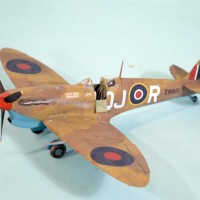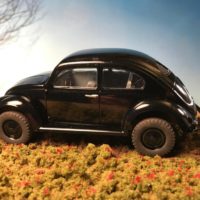"Southern Stars" - Eduard 1/48 Spitfire Vb (trop) – Neville Duke
The Airplane:
Late in 1940, the RAF believed the appearance of the pressurized Junkers Ju 86P over Britain would signal the start of a high altitude bombing offensive by the Luftwaffe. The Air Ministry called for development of a pressurized Spitfire, with a new Merlin; this became the Mk VI. Due to the time it would take to develop the new fighter, an emergency stop-gap measure was needed, which became the Mk V.
Basically, the Mk V was a Mk I airframe strengthened tp take the Merlin 45 engine, which delivered 1,440 hp, and incorporated a new single-speed single-stage supercharger. The carburetor was also modified to allow zero gravity maneuvers without fuel flow cutoff. Supermarine began delivery of the Mk V in early 1941 as the Mk. Va (Type 331) of which 94 were constructed with the original eight-gun wing, and the Mk Vb (Type 349) armed with two 20mm Oerlikon cannon; the Vb became the main production version.
Over the course of production, changes were incorporated, some of which became standard on all later Spitfires. Starting in early 1941 the round section exhaust stacks were changed to a fishtail type, marginally increasing exhaust thrust. After some initial problems with the Mk I oil coolers, a larger one that could be recognized by a deeper housing with a circular entry was fitted. Metal ailerons were added in May 1941, improving roll and overall maneuverability. In early 1942, a "blown" cockpit canopy was introduced to increase the pilot's head-room. Many mid to late production Vbs used the improved windscreen the internally-mounted armored glass windscreen. Because this was taller than that of the earlier version, canopies were not interchangeable and could be distinguished by the wider rear framing used with the late-style windscreen.
Different propellers were fitted, according to which factory built the airframe: Supermarine and Westland-manufactured Vbs used de Havilland constant speed props with narrow metal blades like the Mk I, while Castle Bromwich airplanes were fitted with either a wide-bladed Rotol constant speed propeller with metal blades 10 ft 9 in diameter, or a Rotol unit with “Jablo” (compressed wood) blades, The Rotol spinners were longer and more pointed than the de Havilland, increasing overall length by 3.5 in; they gave a modest increase in speed overr 20,000 ft and increased service ceiling. Many Spitfire Vbs were fitted with "gun heater intensifier" systems on the exhaust stacks, identified by a short tubular intake on the first stack and a narrow pipe into the cowling from the rear exhaust. The Mk V was the first Spitfire able to carry specially-designed slipper-type drop tanks.
Neville Duke:
Neville Frederick Duke, DSO, OBE, DFC & Two Bars, AFC, FRAeS was a British fighter ace and later test pilot. He was the top-scoring Allied ace in the North Africa campaign, credited with the destruction of 27 enemy aircraft. In 1953, he set a World Air Speed Record of 727.63 mph (1,171.01 km/h) in a Hawker Hunter.
Duke attempted to join the Fleet Air Arm on his 18th birthday. He was rejected and joined the RAF instead as a cadet in June 1940. On completing flying training, he was commissioned a Pilot Officer at No. 58 Operational Training Unit in February 1941. He was posted to 92 Squadron at Biggin Hill in April. Duke's obvious talents as a fighter pilot meant he often flew as wingman to Biggin Hill's wing leader, Wing Commander Adolph "Sailor" Malan. By August 1941, he had claimed two Bf 109s shot down. When 92 was withdrawn for a rest in October 1941, Duke was posted to North Africa to fly with No. 112 Squadron on the Curtiss Tomahawk.
On November 30, 1941, Duke was shot down by Oberfeldwebel Otto Schulz from JG 27.On December 5, he was again shot down by a JG 27 pilot and wounded by splinters in the leg. He managed to crash-land near Tobruk and was sent back to Cairo. By February 1942, after the squadron was re-equipped with the Curtiss Kittyhawk, Duke had eight victories and was awarded the DFC in March. He completed his first tour of operations the next month and then spent six months instructing at the fighter school in the Canal Zone.
In November 1942, Duke rejoined 92 Squadron, flying the Spitfire Vb. Promoted to flight commander in February 1943, he was awarded the DSO in March. By the end of his second tour in June, Duke had amassed 22 victories and was awarded a bar to his DFC.
Promoted to Squadron Leader, Duke was posted to 73 OTU at Abu Sueir as chief flying instructor before returning to operations in March 1944 for his third tour, as OC 145 Squadron in Italy, flying Spitfire VIIIs. He claimed five more aircraft shot down in May, gaining a second bar to his DFC. On June 7, 1944, Duke was shot down by flak and bailed out into Lake Bracciano, almost drowning when unable to release his parachute harness. He sheltered with Italian partisans until U.S. troops arrived.
Duke scored his final victories - two Fw-190F's of SG 4 -on September 7. 1944, becoming the Mediterranean Theatre's top Allied fighter ace at age 22. In 486 sorties and 712 operational hours, he claimed 27 victories and two shared, one probable, six damaged and two shared destroyed on the ground.
The Kit:
“Spitfire Story: Southern Stars” is another Eduard Limited Release kit, which includes parts to create both early and late Spitfire Vb's, of which there are four markings options included, as well as a Spitfire Vc, which has six decal options. The plastic is what has been seen in earlier releases. There are all the usual Profipack add-ons in addition to an enormous decal sheet; these include photo-etch cockpit detail and canopy painting masks. As is usual with a Profipack release, if one bought the kit separately and then added in the photoetch and aftermarket decals, this release is a bargain.
The decal sheet includes the options of doing Neville Duke's second Spitfire Vb ER821 and Ian Gleed's Spitfire Vb AB502; both of these were available on the now OOP “Spitfire: Aces of the Empire” sheet and it is nice to see them done accurately here.
Construction:
One thing you should do is determine whether the particular Spitfire Vb you want to do is an “early,” “mid,” or “late” production airplane. Eduard provides two different fuselage halves, that cater to early or late production aircraft. The old Harleyford Spitfire book that has been in my library for mumblemumble decades has a chapter that lists by serial numbers all production runs of all marks of Spitfire. If you don't have that list, another way of making a general determination is to note whether your choice uses the early windscreen with the separate armor glass and the flat-sided canopy, which marks an early-production version; if it has the later windscreen with the integral armor plate and the flat-sided canopy (which can always be distinguished by that port on the left side), that is most likely a mid-production airplane; if it has the later windscreen and the blown “bubble” hood, that is a late-production VB. The Spitfire Vb/Trop (late)ONLY used the later windscreen with blown canopy. Most used the Rotol prop with wooden blades or the DeHavilland metal prop with wider blades, which is not included in the kit but can be created by modifying one of the props that are there; fortunately all the options in this kit used the Rotol prop.
I opted to assemble this kit by changing the method of attaching the wing. After assembling the gear well parts in the lower wing, I attached the lower wing to the completed fuselage, then attached the upper wing parts. I was able to get a nice tight fit without all the “pushing and shoving” one goes through if you assemble the wing sub-assembly completely and then mate it to the fuselage sub-assembly. Then attach each upper wing part, starting at the wing-fuselage joint. This solves the one “fiddly” item in constructing this kit and insures you need no putty on any joint.
Painting and Decals:
The Spitfire Vb options in this kit were repainted in the desert scheme at the Aboukir depot; the result is an “approximation” of the “A” or “B” scheme - it's a good idea to follow the painting diagrams included here. I used my mixtures for Tamiya paint to do Dark Earth, Middle Stone and Azure Blue, applied freehand with my Paasche-H using a No. 1 fine tip. I went back over each upper surface color three times, adding in first a bit of light grey, then a bit of yellow, and then white, to simulate sun-fading under the hot North African sun.
Decals:
I used the option for Neville Duke. This is for his second Spitfire Vb, which has only had accurate decals available before in “Spitfire: Aces of the Empire.” There's a lot of recent talk about stripping the decal film from the new Eduard decals after they have been applied and set, to obtain the “painted on” look. I'm not one to screw around with the most important part of the model assembly, so that won't be done here; besides, just doing the decals normally also results in a “painted on” look if you have applied them correctly and not gotten air under them, which creates silvering.
Final Assembly:
I gave the model a coat of really flat “flat clear” to simulate the sun-bleached look of an airplane in North Africa. I then applied a greyed-out exhaust stain since the engines were run lean, and dinged the airframe. I attached the prop, unmasked the canopy and posed it open.
Overall:
Eduard's Spitfire releases are all “definitive.” If you use tricks like I have learned with the wing-fuselage assembly, their fiddliness is solved. You have to bring you're a game to any of these kits, to match what the kit presents. Take your time, take care, be sure to clean off all mating surfaces, and the result will be an excellent model. I personally think Eduard's 1/48 kits are now the best in the hobby - they leave Tamiya in the dust, if one understands that accuracy and ease of construction are two separate issues. Recommended for all Spitfire fans. There will never be “too many Spitfires” here at Le Chateau du Chat.




















Looks great! I've always loved the contrast between the light blue and tan colors found on the North African campaign planes.
Great stuff Tom @tcinla I've been fence sitting on this kit because I have over 200 kits in the stash not yet built but damn, I think I have to pick this one up.
Amazing build, Tom, yet another Spit added to your ever growing collection! Great article, loved every part of it.
Another fine effort by Mr. C
Excellent result, Tom @tcinla
Your supporting article is very interesting as well.
Still need to have a nice Spitfire on my shelf and this one seems a very good candidate.
Another source of inspiration to build a Mk Vb.
And you’re correct Tom - no such thing as ‘too many Spitfires’!
Looks great as usual Tom! Well done.
Nice work, Tom. The colors and exhaust staining looks perfect.
I really like your paintwork! Also story was pleasure to read.
Another nice Spit and text TC @tcinla. I have yet to build a tropical V. I need to get on it.
Nice work , another great looking Spitfire.